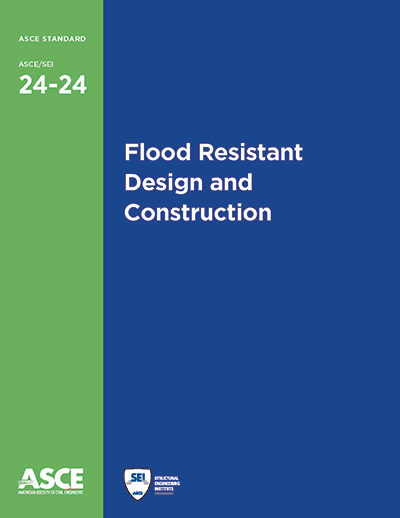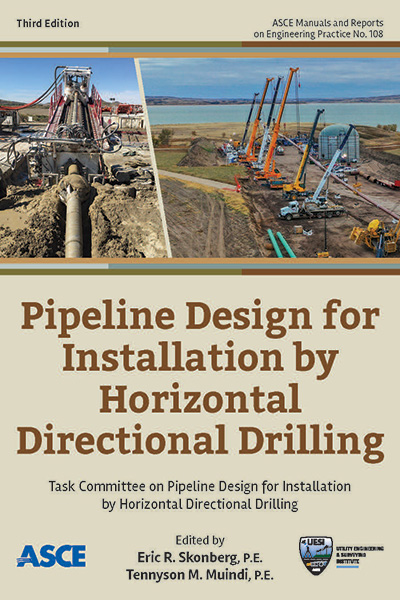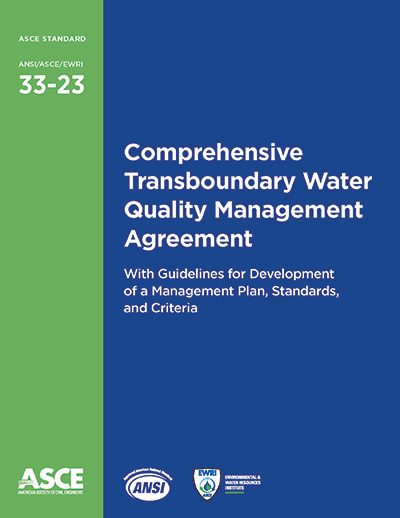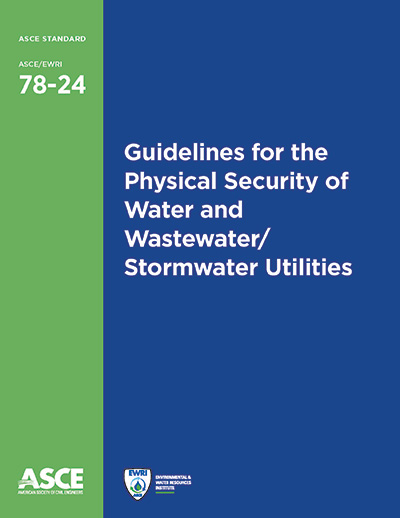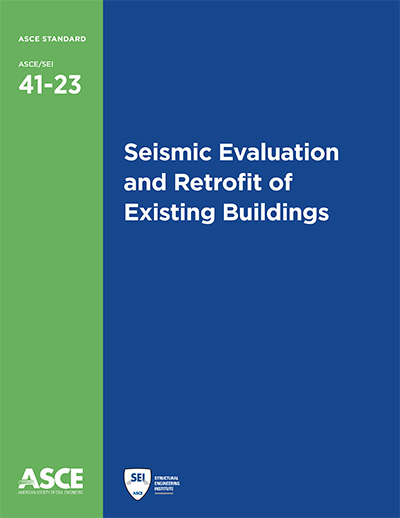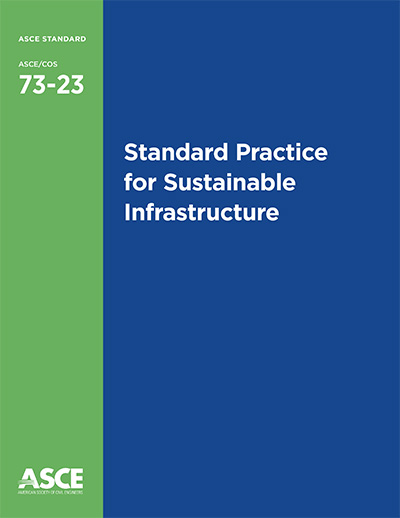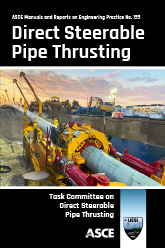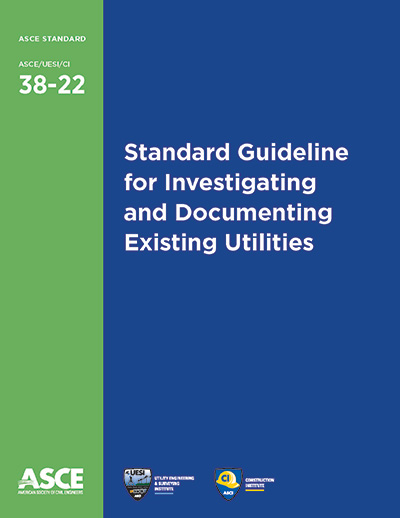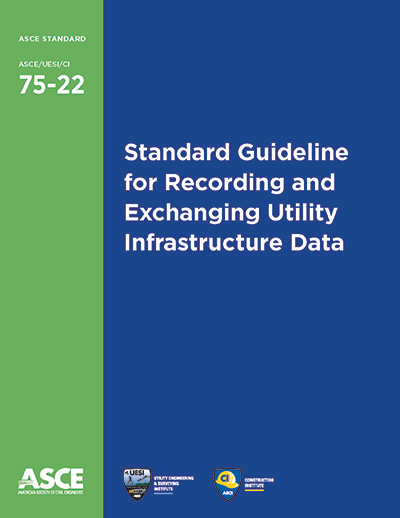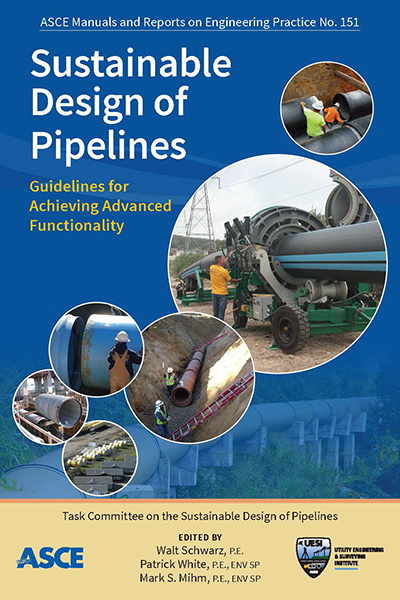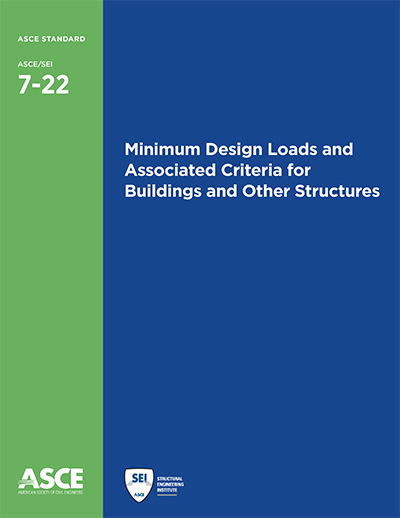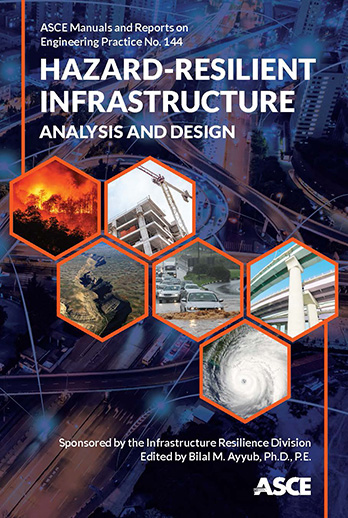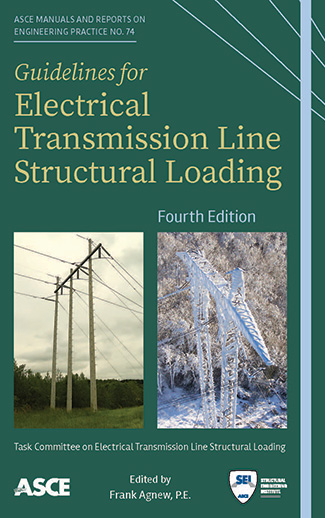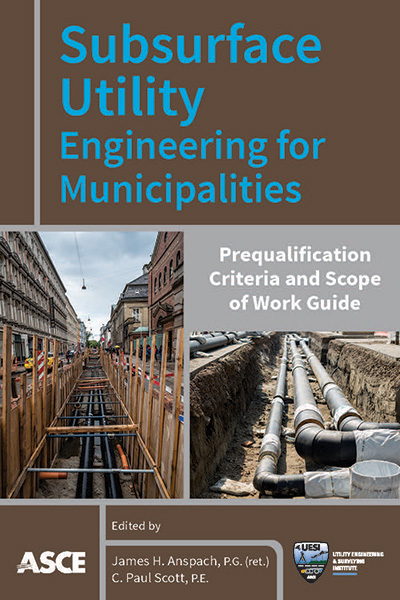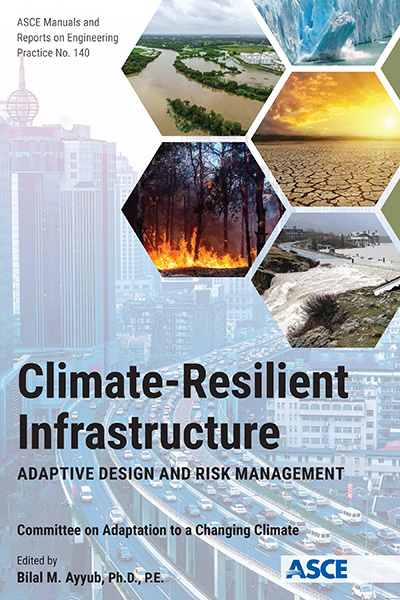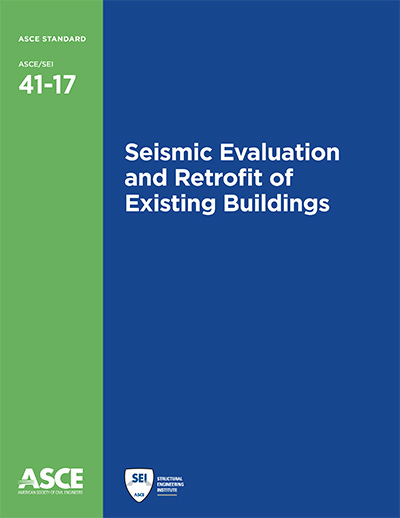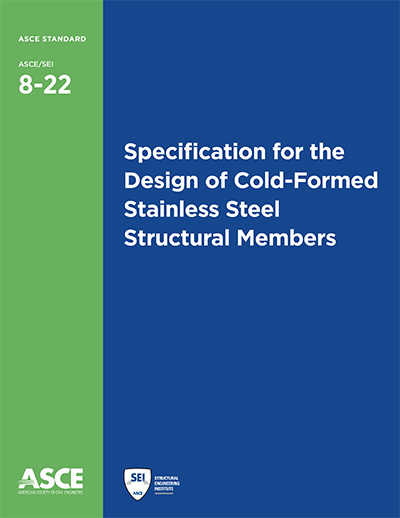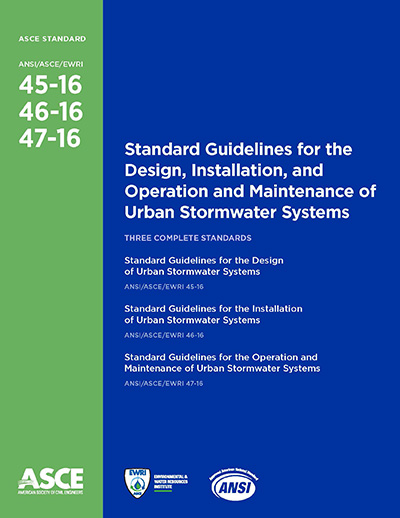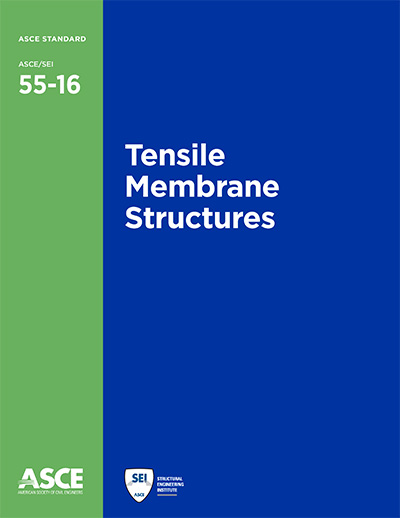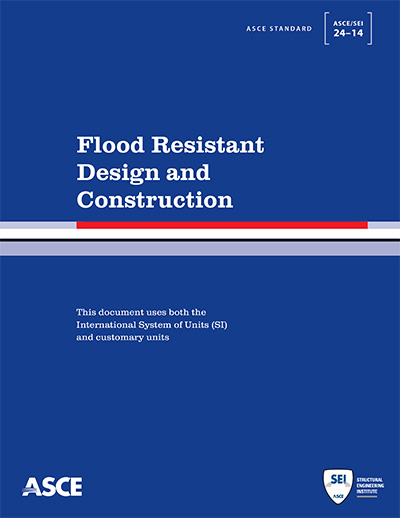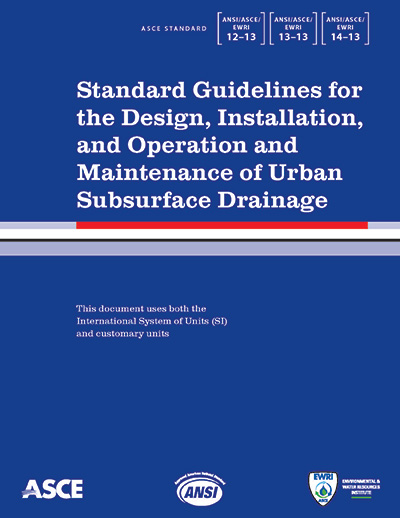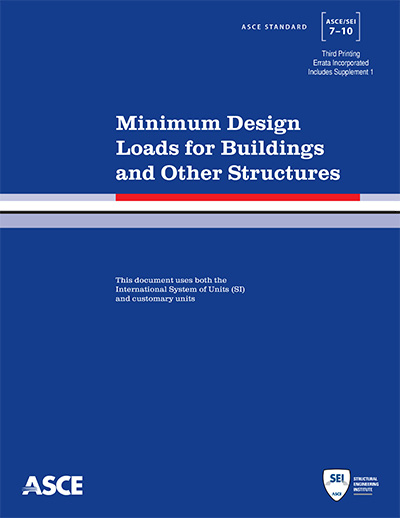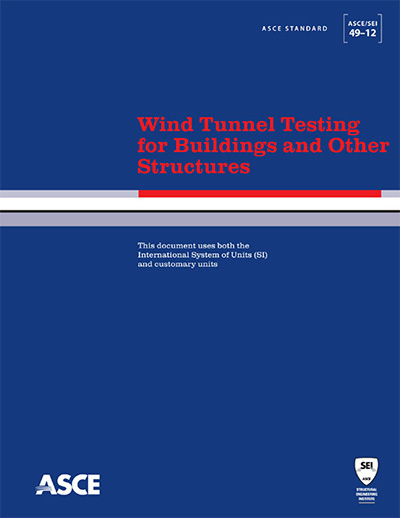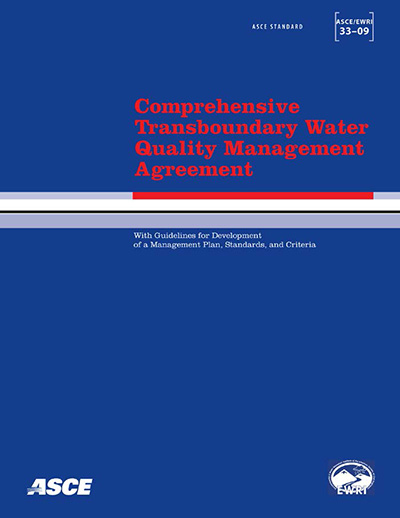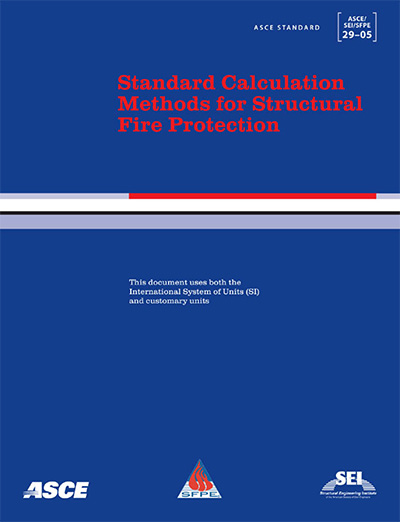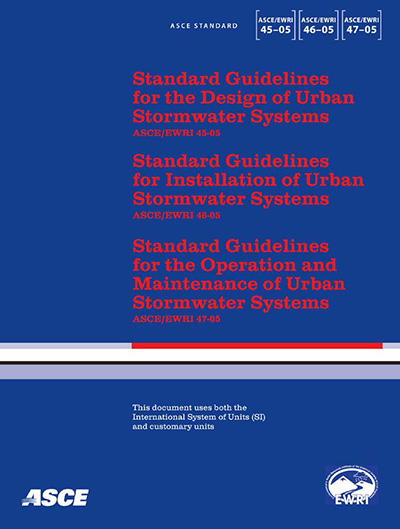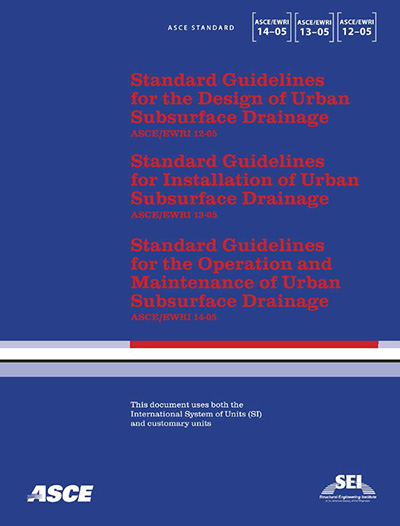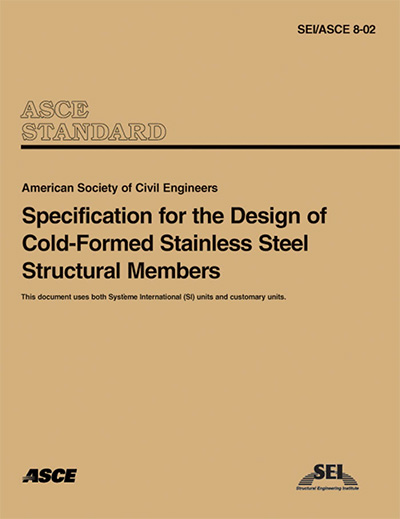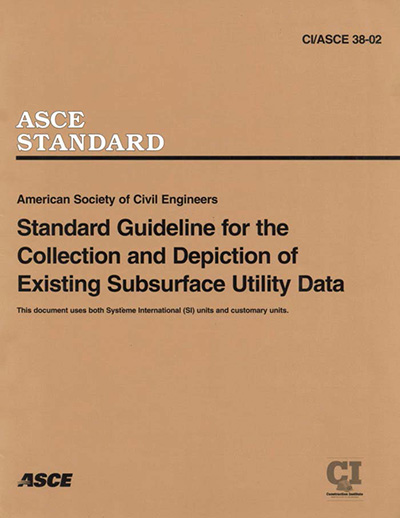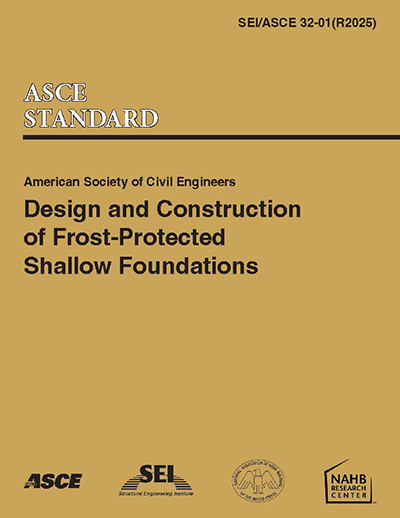Standards
The American Society of Civil Engineers - Going beyond printed standards though easy online access of ASCE’ standards with enhanced commentary, complete internal linking, deep searching capabilities, and extensive linking to papers, webinars, guides, and other resources!
ASCE/SEI 24-24
Flood Resistant Design and Construction
Show descriptionProvides minimum requirements for flood resistant design and construction of structures that are subject to building code requirements or floodplain management regulations in flood hazard areas. This standard applies to new construction, including subsequent work to such structures, and work classified as substantial improvement of existing structures that are not historic structures.MOP 108
Pipeline Design for Installation by Horizontal Directional Drilling
Show descriptionAddresses the design of major pipeline or duct segments to be installed by horizontal directional drilling (HDD) and discusses updates in drilling equipment, improvements for tracking, and considerations for using alternative pipe materials.ANSI/ASCE/EWRI 33-23
Comprehensive Transboundary Water Quality Management Agreement, With Guidelines for Development of a Management Plan, Standards, and Criteria
Show descriptionServes as a comprehensive framework designed to assist riparian governments in effectively managing shared water resources. This agreement offers practical guidance for national and state governments, as well as other stakeholders involved in establishing water quality standards for sustainable management of transboundary water resources.ASCE/EWRI 78-24
Guidelines for the Physical Security of Water and Wastewater/Stormwater Utilities
Show descriptionProvides guidelines on the evaluation and enhancement of physical security of facilities used in potable water sources, treatment, and distribution systems, as well as for wastewater and stormwater facilities. It provides a holistic approach to integrate modern security practices into the management, operation, construction, or retrofit of water, wastewater, and stormwater systems.ANSI/ASCE/EWRI 39-23
Guidelines for Operational Hail Suppression Programs
Show descriptionProvides a general overview of the science and technology of hail suppression combined with specific strategies and procedures required to design, conduct, and evaluate hail suppression operations. Such operational activities as airborne, ground-based, and rocket and artillery delivery systems are addressed. The standard includes both mandatory and advisory provisions.ASCE/SEI 41-23
Seismic Evaluation and Retrofit of Existing Buildings
Show descriptionASCE/SEI 41-23 describes deficiency-based and systematic procedures that use performance-based principles to evaluate and retrofit existing buildings to withstand the effects of earthquakes. The standard presents a three-tiered process for seismic evaluation according to a range of building performance levels by connecting targeted structural performance and the performance of nonstructural components with seismic hazard levels. The deficiency-based procedures allow evaluation and retrofit efforts to focus on specific potential deficiencies deemed to be of concern for a specified set of building types and heights. The systematic procedure, applicable to any building, sets forth a methodology to evaluate the entire building in a rigorous manner.ASCE/COS 73-23
Standard Practice for Sustainable Infrastructure
Show descriptionASCE/COS 73-23 addresses development and implementation of sustainable infrastructure solutions through the entire infrastructure life cycle. It can be used for infrastructure solutions of any scale, although it is specifically not intended to unduly burden small projects.MOP 155
Direct Steerable Pipe Thrusting
Show descriptionDetails how engineers and construction professionals can utilize the Direct Steerable Pipe Thrusting (DSPT) method, also known as Direct Pipe, a relatively recent innovation in the trenchless pipeline installation industry, which combines characteristics of horizontal directional drilling (HDD) and conventional microtunneling to design and install pipelines in ground conditions that would be challenging for other trenchless methods.MOP 92
Manhole Inspection and Rehabilitation
Show descriptionProvides a valuable update to the Manual of Practice to reflect current practices in both the inspection and rehabilitation of manholes.ASCE/UESI/CI 38-22
Standard Guideline for Investigating and Documenting Existing Utilities
Show descriptionEndeavors to safeguard public welfare by providing guidance on performing utility investigations and documenting results in a standardized fashion.ASCE/UESI/CI 75-22
Standard Guideline for Recording and Exchanging Utility Infrastructure Data
Show descriptionSpecifies essential elements for documenting the location, geometry, and feature attributes of underground and aboveground utility infrastructure, with a particular focus on enabling creation of 3D digital twins for newly installed and/or exposed utility infrastructure.MOP 152
Surveying and Geomatics Engineering
Show descriptionA comprehensive yet general overview to help support education and inform practicing engineers on the important role of the surveying engineer. It provides a much-needed update on the modern practice of surveying and geomatics engineering.MOP 151
Sustainable Design of Pipelines
Show descriptionProvides a conceptual tool and a decision process that can be used to evaluate the potential impacts of a project and promote improvement in sustainable planning, design, construction, and operation to create a project that goes beyond the typical standards of care for pipelines used by the water, wastewater, and storm water industry.ASCE/SEI 49-21
Wind Tunnel Testing for Buildings and Other Structures
Show descriptionASCE/SEI 49-21 provides the minimum requirements for conducting and interpreting wind tunnel tests to determine wind loads on buildings and other structures. Wind tunnel tests are used to predict wind loads and responses of a structure, structural components, and cladding to a variety of wind conditions. This standard includes commentary that elaborates on the background and application of the requirements.ASCE/SEI 7-22
Minimum Design Loads and Associated Criteria for Buildings and Other Structures
Show descriptionASCE/SEI 7-22 provides the most up-to-date and coordinated loading provisions for general structural design. This standard prescribes design loads for all hazards including dead, live, soil, flood, tsunami, snow, rain, atmospheric ice, seismic, wind, and fire, as well as how to evaluate load combinations. The 2022 edition of ASCE 7, which supersedes ASCE 7-16, coordinates with the most current structural material standards including those from ACI, AISC, AISI, AWC, and TMS.MOP 145
Design of Close-Fit Liners for the Rehabilitation of Gravity Pipes
Show descriptionProvides a comprehensive source of information on the design of flexible, close-fit linings for the renewal or rehabilitation of pipes designed for gravity flow such as sanitary sewers, culverts, and storm sewers.MOP 144
Hazard-Resilient Infrastructure
Show descriptionprovides guidance and an underlying framework for creating consistency across hazards, systems, and sectors in the design of new infrastructure systems. The book also discusses enhancing the resilience of existing systems and relates this framework to the economics associated with system lifecycle, including organizational and socioeconomic considerations.MOP 74
Guidelines for Electrical Transmission Line Structural Loading
Show descriptionProvides the most current and relevant loading concepts and applications specific to transmission line design. A valuable resource for the development of a loading philosophy for electrical transmission structures, the information presented can be applied to an individual project or at a regional level.MOP 115
Pipe Ramming
Show descriptionDescribes current pipe ramming practices in design and construction of pipelines under roads, railroads, streets, and other constructed and natural structures and obstacles.SUE
Subsurface Utility Engineering for Municipalities
Show descriptionA resource for understanding subsurface utility engineering (SUE) and bringing up-to-date practices to the application of SUE for public works projects. SUE incorporates existing and emerging technology to identify, characterize, and map underground utility facilities throughout the project development process.MOP 140
Climate-Resilient Infrastructure
Show descriptionProvides guidance for and contributes to the developing or enhancing of methods for infrastructure analysis and design in a world in which risk profiles are changing and can be projected with varying degrees of uncertainty requiring a new design philosophy to meet this challenge.ASCE/SEI 41-17
Seismic Evaluation and Retrofit of Existing Buildings
Show descriptionASCE/SEI 41-17, describes deficiency-based and systematic procedures that use performance-based principles to evaluate and retrofit existing buildings to withstand the effects of earthquakes. The standard presents a three-tiered process for seismic evaluation according to a range of building performance levels by connecting targeted structural performance and the performance of nonstructural components with seismic hazard levels. The deficiency-based procedures allow evaluation and retrofit efforts to focus on specific potential deficiencies deemed to be of concern for a specified set of building types and heights. The systematic procedure, applicable to any building, sets forth a methodology to evaluate the entire building in a rigorous manner.ASCE/SEI 8-22
Specification for the Design of Cold-Formed Stainless Steel Structural Members
Show descriptionASCE/SEI 8-22 provides design criteria for the determination of the strength of stainless steel structural members and connections for use in buildings and other statically loaded structures. It is an update to ASCE 8-02 that aligns the design of cold-formed stainless steel structures with the latest findings in both stainless steel and carbon steel research and practice. It also provides requirements specific to stainless steel structures that greatly exceed those of typical carbon steel applications.ASCE/SEI 7-16
Minimum Design Loads and Associated Criteria for Buildings and Other Structures
Show descriptionASCE 7-16 provides the most up-to-date and coordinated loading standard for general structural design. ASCE 7-16 describes the means for determining design loads including dead, live, soil, flood, tsunami, snow, rain, atmospheric ice, earthquake, wind, and fire, as well as how to assess load combinations. The 2016 edition of ASCE 7, which supersedes Standard ASCE/SEI 7-10, coordinates with the most recent material standards, including ACI, AISC, AISI, AWC, and TMS standards.ANSI/ASCE/EWRI 62-16, 63-16, 64-16
Standard Guidelines for the Design, Installation, and Operation and Maintenance of Stormwater Impoundments
Show descriptionPublished as a single volume, these standards establish guidelines for the design, installation, and operation and maintenance of stormwater impoundments.ANSI/ASCE/EWRI 45-16, 46-16, 47-16
Standard Guidelines for the Design, Installation, and Operation and Maintenance of Urban Stormwater Systems
Show descriptionPublished as one volume, these three standards provide guidance for the design of urban stormwater systems, covering topics such as site analysis, system configuration, hydrology, hydraulic design, nonstructural considerations, structural design, and materials.ASCE/SEI 55-16
Tensile Membrane Structures
Show descriptionASCE/SEI 55-16 provides minimum criteria for the analysis, design, and performance of membrane-covered cable and rigid member structures, collectively known as tensile member structures. The standard is applicable to both permanent and temporary structures. The requirements of this standard apply whether the tensile membrane structure is independent of or attached to another structure. ASCE 55-16 updates the previous edition and now includes both load resistance factor design (LRFD) and allowable stress design (ASD) load combinations. This new edition incorporates air-supported structures in addition to conventional tensile membrane structures and frame-covered membrane structures, all in a single standard.ASCE/SEI 19-16
Structural Applications of Steel Cables for Buildings
Show descriptionASCE/SEI 19-16 provides requirements for the structural design, fabrication, and installation of cables for use as static structural elements to support and brace buildings and other cable-supported structures. Covering both carbon-steel and stainless-steel cables, this standard addresses roofs, floors, curtain walls, masts, and nets, but it is not applicable for structures subjected primarily to vehicle loads or for guyed electrical transmission towers.ANSI/ASCE/EWRI 39–15
Guidelines for Operational Hail Suppression Programs
Show descriptionDescribes the process for designing, conducting, and evaluating operations to suppress the formation of hail. Hail is the product of vigorous, deep convection in the atmosphere. The most common approaches to hail suppression involve seeding a storm with nucleating agents using airborne, ground-based, or rocket and artillery delivery systems.ASCE/SEI 24-14
Flood Resistant Design and Construction
Show descriptionASCE/SEI 24-14 provides minimum requirements for design and construction of structures located in flood hazard areas and subject to building code requirements. Identification of flood prone structures is based on flood hazard maps, studies, and other public information. This standard applies to new structures, including subsequent work, and to work classified as substantial improvement of existing structures that are not historic. Standard ASCE/SEI 24-14 introduces a new concept, Flood Design Class, that bases requirements for a structure on the risk associated with unacceptable performance.ANSI/ASCE/EWRI 12-13, 13-13, 14-13
Standard Guidelines for the Design, Installation, and Operation and Maintenance of Urban Subsurface Drainage
Show descriptionThis single-volume set of three standards establishes guidelines for design, installation, and operation and maintenance of urban subsurface drainage systems.ASCE/SEI 7-10
Minimum Design Loads for Buildings and Other Structures
Show descriptionASCE/SEI 7-10 provides requirements for general structural design and includes means for determining dead, live, soil, flood, snow, rain, atmospheric ice, earthquake, and wind loads, as well as their combinations, which are suitable for inclusion in building codes and other documents. This standard, a revision of ASCE/SEI 7-05, offers a complete update and reorganization of the wind load provisions, expanding them from one chapter to six. The standard contains new ultimate event wind maps with corresponding reductions in load factors so that the loads are not affected and updates the seismic loads with new risk-targeted seismic maps. The snow, live, and atmospheric icing provisions are updated as well. In addition, the standard includes a detailed Commentary with explanatory and supplementary information designed to assist building code committees and regulatory authorities.ASCE/SEI 49-12
Wind Tunnel Testing for Buildings and Other Structures
Show descriptionStandard ASCE/SEI 49-12 provides the minimum requirements for conducting and interpreting wind tunnel tests to determine wind loads on buildings and other structures. Wind tunnel tests are used to predict the wind loads and responses of a structure, structural components, and cladding to a variety of wind conditions. This standard includes commentary that elaborates on the background and application of the requirements.ASCE/EWRI 33-09
Comprehensive Transboundary Water Quality Management Agreement
Show descriptionProvides a framework that governments can adopt or modify with regard to riparian rights. Governments seeking to manage and preserve shared water resources will find this model and its appendixes to be a practical guide. Various aspects of planning and management are analyzed in detail, including administration, water quality and allocation, financing, and dispute resolution. This standard can be used on an international scale and in a variety of geopolitical settings.ASCE/SEI/SFPE 29-05
Standard Calculation Methods for Structural Fire Protection
Show descriptionASCE/SEI/SFPE 29-05 provides the most current and proven methods for calculating the fire resistance of selected structural members and barrier assemblies made from structural steel, plain concrete, reinforced concrete, timber and wood, concrete masonry, and clay masonry. This standard, a thorough revision of ASCE/SEI/SFPE Standard 29-99, is a joint effort between ASCE's Structural Engineering Institute and the Society of Fire Protection Engineers.ASCE/EWRI 45-05, 46-05, 47-05
Standard Guidelines for the Design of Urban Stormwater Systems, Standard Guidelines for Installation of Urban Stormwater Systems, and Standard Guidelines for the Operation and Maintenance of Urban Stormwater Systems
Show descriptionThree standards are combined in this single volume to provide guidance for the design, installation, operation, and maintenance of urban stormwater systems.ASCE/EWRI 12-05, 13-05, 14-05
Standard Guidelines for the Design of Urban Subsurface Drainage, Standard Guidelines for the Installation of Urban Subsurface Drainage, and Standard Guidelines for the Operation and Maintenance of Urban Subsurface Drainage
Show descriptionThree standards are combined in this single volume to provide guidelines for design, installation, operation, and maintenance of urban subsurface drainage systems.SEI/ASCE 08-02
Specification for the Design of Cold-Formed Stainless Steel Structural Members
Show descriptionSEI/ASCE 8-02 provides design criteria for the determination of the strength of stainless steel structural members and connections for use in buildings and other statically loaded structures. The members may be cold-formed to shape from annealed and cold-rolled sheet, strip, plate, or flat bar stainless steel material. Design criteria are provided for axially loaded tension or compression members, flexural members subjected to bending and shear, and members subjected to combined axial load and bending. The specification provides the design strength criteria using load and resistance factor design (LRFD) and the allowable stress design (ASD) methods. The reasoning behind and the justification for various provisions of the specification are also presented.CI/ASCE 38-02
Standard Guidelines for the Collection and Depiction of Existing Subsurface Utility Data
Show descriptionPresents a credible system for classifying the quality of utility location information that is placed in design plans.SEI/ASCE 32-01 (R2025)
Design and Construction of Frost-Protected Shallow Foundations
Show descriptionThis standard addresses the design and construction of frost-protected shallow foundations in areas subject to seasonal ground freezing. Foundation insulation requirements to protect heated and unheated buildings from frost heave are presented in easy-to-follow steps with reference to design tables, climate maps, and other necessary data to furnish a complete frost-protection design. The advantages of this technology include improved construction efficiency over conventional practices, increased energy efficiency, minimized site disturbance, and enhanced frost protection. A commentary is included to provided background information and important technical insights.

